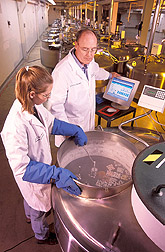This page has been archived and is being provided for reference purposes only. The page is no longer being updated, and therefore, links on the page may be invalid.
National Germplasm Repository Receives Semen from Historic Bulls
By Marty ClarkJune 23, 2005
Scientists with the Agricultural Research Service (ARS) are busy cataloguing a valuable collection of genetic material that could help breeders preserve the genetic diversity of beef and dairy cattle.
Thousands of samples of bull semen were donated last year to ARS by ABS Global, a major livestock artificial insemination company based in DeForest, Wis. The company donated its historic bull semen collection to the ARS National Animal Germplasm Program (NAGP) at the National Center for Genetic Resources Preservation, in Fort Collins, Colo.
The company's collection, which dates from the 1960s, contains more than 200,000 units of semen from 6,000 bulls representing 43 beef and dairy breeds.
ARS , the U.S. Department of Agriculture's chief in-house scientific research agency, is responsible for preserving genetic material--such as seeds, plant cuttings and semen--in germplasm repositories around the country.
ABS Global announced its donation last fall at the American Dairy Science Association conference on genetic resources in Cheyenne, Wyo. The NAGP received the collection in March. Since then, ARS animal geneticist Harvey D. Blackburn has been incorporating the donation into the germplasm system.
The new material will make it possible to research genetic changes in a breed over a 30-year period. Not only does it broaden the existing NAGP collection, it strengthens strategic germplasm reserves and provides DNA for bovine genome researchers and for industry partners to develop animals with key traits such as disease resistance and improved meat and milk production.

